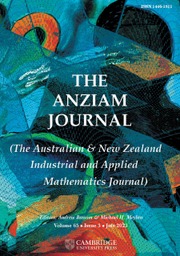No CrossRef data available.
Article contents
The transition through resonance of a nonlinear non-autonomous system
Published online by Cambridge University Press: 17 February 2009
Abstract
Core share and HTML view are not available for this content. However, as you have access to this content, a full PDF is available via the ‘Save PDF’ action button.
An approximate nonlinear perturbation analysis for the re-entry roll resonance model is given. The results are used to identify the dynamic processes involved, as characterised by terms in the model equations, and to suggest a prudent management rule for this and similar transiently-resonant systems.
- Type
- Research Article
- Information
- Copyright
- Copyright © Australian Mathematical Society 1992
References
[1] Chapman, P. B., “A uniform description of an oscillator's resonant transition,” J. Aust. Math. Soc. (B) 32 (1990) 193–206.CrossRefGoogle Scholar
[2] Guckenheimer, J. and Holmes, P., Nonlinear oscillations, dynamical systems, and bifurcations of vector fields. (Springer-Verlag, N.Y., 1983).CrossRefGoogle Scholar
[3] Kath, W. L., “Necessary conditions for sustained resonance.” SIAM J. Appl. Math. 43 (1983) 314–322.CrossRefGoogle Scholar
[4] Kath, W. L., “Conditions for sustained resonance.” SIAM J. Appl. Math. 43 (1983) 579–583.CrossRefGoogle Scholar
[5] Kevorkian, J., “On a model for re-entry roll resonance.” SIAM J. Appl. Math. 26 (1974) 638–669.CrossRefGoogle Scholar
[6] Kevorkian, J., “Perturbation techniques for oscillatory systems with slowly varying co-efficients.” SIAM Review 29 (1987) 391–461.CrossRefGoogle Scholar
[7] Lighthill, M. J., “A technique for rendering approximate solutions to physical problems uniformly valid.” Philos. Mag. 7, 40 (1949) 1179–1201.CrossRefGoogle Scholar
[9] Watson, G. N., Theory of Bessel functions. Second edition. (C.U.P., London, 1962).Google Scholar


